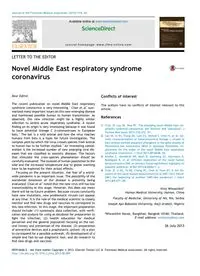
2014 Novel Middle East respiratory syndrome coronavirus PDF
Preview 2014 Novel Middle East respiratory syndrome coronavirus
LETTER TO THE EDITOR Novel Middle East respiratory syndrome coronavirus Dear Editor, The recent publication on novel Middle East respiratory syndrome coronavirus is very interesting.1 Chan et al1 sum- marized many important issues on this new emerging disease and mentioned possible human to human transmission. As observed, this new infection might be a highly similar infection to severe acute respiratory syndrome. A recent finding on its origin is very interesting because it was found to have potential lineage C b-coronaviruses in European bats.2 The bat is a wild animal and how the virus reaches humans from bats is a topic for future investigation. The complex path by which the virus crosses species from animal to human has to be further studied.3 An interesting consid- eration is the increased number of new emerging viral dis- eases that are classified as zoonotic diseases. The factors that stimulate the cross-species phenomenon should be carefully evaluated. The invasion of human population to the wild and the increased temperature due to global warming have to be explored for their actual effects. Focusing on the present situation, the fear of a world- wide pandemic is an important issue. The possibility of the worldwide extension of the disease is presently being evaluated. Chan et al4 noted that the new virus still has low transmissibility at this stage. However, this does not mean there will be no future problem. Because viruses constantly have new mutations, new problematic viruses can appear at any time. It is the role of the medical scientist to closely monitor and find new drugs and vaccines to correspond to this new infection. At this stage, the important preparation should include: (1) systematic data collection, with verifi- cation and analysis for using as database for preparation to fight the infection; (2) health education for medical personnel and the general population focusing on the nat- ural history and prevention of the disease; (3) preparation of preventive devices and a prophylactic system; (4) a plan to correspond for a possible outbreak; (5) development of a simple and fast-to-use diagnostic tool; and (6) research to find new drugs and vaccines. Conflicts of interest The authors have no conflicts of interest relevant to this article. References 1. Chan JF, Lau SK, Woo PC. The emerging novel Middle East res- piratory syndrome coronavirus: the "knowns" and "unknowns". J Formos Med Assoc 2013;112:372e81. 2. Lau SK, Li KS, Tsang AK, Lam CS, Ahmed S, Chen H, et al. Ge- netic characterization of betacoronavirus lineage c viruses in bats reveals marked sequence divergence in the spike protein of Pipistrellus bat coronavirus HKU5 in Japanese Pipistrelle: im- plications for the origin of the novel Middle East respiratory syndrome coronavirus. J Virol 2013;87:8638e50. 3. Kindler E, Jo´nsdo´ttir HR, Muth D, Hamming OJ, Hartmann R, Rodriguez R, et al. Efficient replication of the novel human betacoronavirus EMC on primary human epithelium highlights its zoonotic potential. M Bio 2013;4:e00611e2. 4. Chan JF, Li KS, To KK, Cheng VC, Chen H, Yuen KY. Is the dis- covery of the novel human betacoronavirus 2c EMC/2012 (HCoV- EMC) the beginning of another SARS-like pandemic? J Infect 2012;65:477e89. Viroj Wiwanitkit* Hainan Medical University, Hainan, China Faculty of Medicine, University of Ni�s, Ni�s, Serbia Joseph Ayo Babalola University, Ikeji-Arakeji, Nigeria *Wiwanitkit House, Bangkhae, Bangkok 10160, Thailand. E-mail address:
